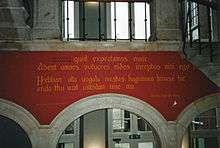Hebban olla vogala
"Hebban olla vogala", sometimes spelled "hebban olla uogala", are the first three words of an 11th-century text fragment written in Old Dutch. The fragment was discovered in 1932 on the flyleaf of a manuscript that was probably made in the abbey of Rochester, Kent and is kept in Oxford.[1] It is usually considered to represent a West Flemish variant of Old Low Franconian.[2]

An often cited poem, it was long believed by many Dutch people to be the only text remaining of Old Dutch. However, experts were already aware of other sources that were then not yet easily accessible. Today, more than 42,000 Old Dutch words and phrases from sources such as the Wachtendonck Psalms and the Leiden Willeram have been discovered, with the oldest definitive source being the Salian Law.[3]
Text
The complete text, a probatio pennae or "scribble" by a monk to try out his pen, is usually transcribed as Hebban olla uogala nestas hagunnan hinase hic enda thu uuat unbidan uue nu. This is a word-for-word translation of the Latin sentence written directly above it: Abent[4] omnes uolucres nidos inceptos nisi ego et tu quid expectamus nu(nc). It is roughly translated as: "Have all birds begun nests, except me and you - what are we waiting for?" (Modern Dutch: Zijn alle vogels nesten begonnen, behalve ik en jij - waarop wachten we nu?)
Comparison to Modern Dutch and Modern English
In this comparison similar Modern Dutch and Modern English words (in form and meaning) are chosen to compare them with the Old Dutch equivalents in the sentence. The Dutch sentence is a correct one, although the verb 'begonnen' is usually conjugated with 'zijn' (be) and not with 'hebben' (have). For English the word order had to be adjusted. For 'hinase' and 'unbidan' there are no close matches in either language.
| Old Dutch | Hebban | olla | uogala | nestas | hagunnan | hinase | hic | enda | thu | uuat | unbidan | uue | nu? |
| Dutch | Hebben | alle | vogels | nesten | begonnen | (behalve) | ik | ende/en | u/jij | wat | (ver)beiden | we | nu? |
| English | Have | all | fowls (birds) | nests | begun | (except) | I | and | thou | what | bide (= are waiting for) | we | now? |
The form hinase corresponds morphologically to Modern Dutch tenzij[5] ("unless", from het en zij) and does not seem to have a Modern English cognate.
Origin
The text is usually considered West Flemish; the arguments in favour of this view were advanced by Schönfeld (1933).[6] According to his interpretation, *agunnan, hinase and (as he read it) anda are Ingvaeonic forms whose presence might be expected in any of the coastal dialects of Old Frisian, Old Saxon or Old Frankish. However, the -n of third person plural hebban, which is absent in both Old English and Frisian, identifies the language as Old Dutch. (Old High German habent uses a different stem.) nestas is the plural of a masculine nest that is attested in Middle Dutch and is still present in West Flemish. vogala has an epenthetic vocal of a type also found in certain Old Ghentish words, whereas Old English has fuglas. The form olla is the result of a vowel shift a > o before ll that is thought to have occurred in West Flemish at a very early date, possibly before 900. Finally, hagunnan and hi(c) have a prothetic h; according to Schönfeld, this also points to West Flemish, in which the h is frequently dropped or (in the written language) added before vowels (cf. abent in the Latin version).
Various theories
According to professor Luc de Grauwe of the University of Ghent, the text could equally well be Old English, more specifically Old Kentish.[7][8]
Recently, professor Frits van Oostrom of Utrecht University linked it to the Moorish Kharjas genre, which includes verses sung by women to their absent lovers. He concludes that the fragment was probably written by a woman or from a female perspective.[9]
See also
| Wikimedia Commons has media related to Hebban olla vogala. |
- Gruuthuse manuscript
- History of Dutch
References
- Shelfmark: Oxford, Bodleian Library, MS Bodley 340. The MS contains a collection of Old English sermons by Aelfric. The Dutch text is found on f. 169v and probably dates to the third quarter of the 11th century. See K. Sisam, "MSS. Bodley 340 and 342: Ælfric's Catholic Homilies". The Review of English Studies, 9, 33 (1933), 1-12; E. van Houts, "Contrasts and interaction. Neighbours of nascent Dutch writing: the English, Normans and Flemish (c. 1000-c. 1200)". Queeste 13 (2006), 3-11.
- H. Ryckeboer, "Dutch/flemish in the north of France". In: J. Treffers-Daller & R. Willemyns (eds.), Multilingualism along the German-Roman linguistic border in Europe (2002), 22-35, esp. 22.
- Hoe het nederlands is ontstaan (Dutch)
- For habent.
- INL, Oudnederlands Woordenboek, s.v. hitnesī (portal).
- M. Schönfeld, "Een Oudnederlandsche zin uit de elfde eeuw (met reproduktie)". Tijdschrift voor Nederlandsche Taal- en Letterkunde 52 (1933), 1-8.
- 'Olla vogala' is Engels (in Dutch).
- Luc de Grauwe: "Zijn olla vogala Vlaams, of zit de Nederlandse filologie met een koekoeksei in (haar) nest(en)?" Tijdschrift voor Nederlandse Taal- en Letterkunde, 120 (2004): 44-56.
- van Oostrom, Frits (2006). Stemmen op Schrift (in Dutch). Bert Bakker. ISBN 90-351-2964-4.
